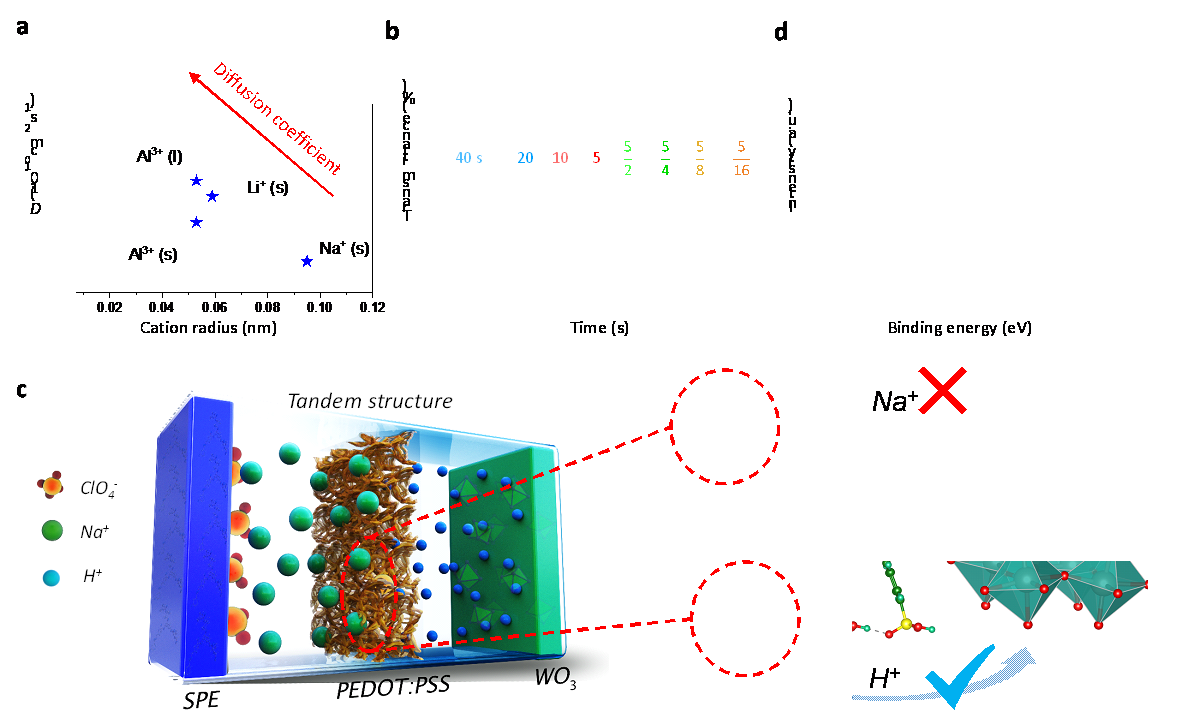- Home
- About Us
- News
-
Research
- State Key Laboratory of High Performance Ceramics
- State Key Laboratory of Functional Crystals and Devices
- The Frontier Department
- Structural Ceramics and Composite Materials
- Information Functional Materials and Devices
- Inorganic Coating Materials
- Artificial Crystal
- Transparent Ceramics
- Energy Materials
- Biomaterials and Tissue Engineering
- Ancient Ceramics and Industrial Ceramics
- Pilot Test for New Materials
- People
- International Cooperation
- Education
- Journals
- Links
Scientists Successfully Fabricated Ultra-fast Response All-solid-state Electrochromic Devices
Electrochromic smart windows, which can regulate the transmittance, adsorption and reflectance of solar radiation by applying a voltage, show great potential in the fields of building and displays for energy saving. Especially in the display field, the slow response speed limits their application in electronic devices.
Recently, the research team led by Profs. JIN Ping and CAO Xun from Shanghai Institute of Ceramics, in collaboration with Prof. SUN Yiyang from Shanghai Institute of Ceramics, Prof. LUO Hongjie from Shanghai University, Prof. John Bell from Queensland University of Technology, and CNBM Bengbu Glass Industry Design and Research Institute, proposed to employ a relay process of proton insertion into the WO3 layer to achieve fast switching speed and high contrast ratio. They successfully fabricated ultra-fast response electrochromic devices, breaking through the limit caused by slow response speed. The response time of the device was reduced to less than 1 s (0.7 s), resulting in a significant reduction of power consumption, thus further promoting the application process of low-power steady-state display devices. Their results were published in Nature Electronics entitled “All-Solid-State Proton-Based Tandem Structures for Fast-Switching Electrochromic Devices”.
The reversible injection and extraction of the extrinsic ions as controlled by electric field form the basic mechanism of a WO3-based ECD. Among these common ions like H+, Li+, Na+ or Al3+, protons with the smallest radius and mass migrate much faster and yield better electrochromic performance.
However, protons are exclusively introduced by liquid electrolytes. The research group find out that PEDOT:PSS can release protons under applied voltage and design an all-solid-state tandem structure for the ECDs, which is composed of an electrochromic WO3 layer and a PEDOT:PSS layer as the solid-state proton source.
Unfortunately, the PEDOT:PSS layer is limited by the amount of removable protons. To solve this problem, the research group further insert an extra SPE layer containing NaClO4 and ferrocene on top of the PEDOT:PSS layer with an aim to use Na+ ions from the SPE layer to pump more protons to the WO3 layer through ion exchange. The first-principles calculation also verified the theoretical feasibility of this proton-relay migration mechanism.
The resulting ECDs exhibit high contrast ratios (>90% at 650 nm), fast responses (coloration to 90% in 0.7 s and bleaching to 65% in 0.9 s and 90% in 7.1 s), good coloration efficiency (109 cm2 C-1 at 670 nm) and excellent cycling stability (<10% degradation of contrast ratio after 3000 cycles). The research group also fabricate large-area (30×40cm2) and flexible devices, illustrating the scaling potential of the approach.
This study was financially supported by the National Natural Science Foundation of China (No. 51972328, No.51903244, No. 62005301, No. 52002392 and No. 11774365), the Youth Innovation Promotion Association, Chinese Academy of Sciences (No. 2018288), Shanghai Sailing Program (No. 19YF1454300, No. 20YF1455400), Shanghai B&R International Cooperation Program (No. 20640770200), the Key Collaborative Research Program of the Alliance of International Science Organizations (No. ANSO-CR-KP-2021-01), Shanghai “Science and Technology Innovation Action Plan” Intergovernmental International Science and Technology Cooperation Program (21520712500).

Fig. 1 Design of the tandem-structure ECD. (a) Diffusion coefficient and radius for different inserting cations in WO3; (b) Transmittance changes at 670 nm with decreasing width of voltage pulses from 40 to 5/16 seconds, where the upper panel is from a PEDOT:PSS/WO3 junction and the lower panel is from a SPE/PEDOT:PSS junction; (c) Schematic for the tandem structure ECD and the key step with a Na+ ion from the SPE layer pumping out a proton from PEDOT:PSS to WO3. (d) XPS spectra of Na 1s from three WO3 samples obtained from WO3, SPE/WO3 and SPE/PEDOT:PSS/WO3 devices. The inset shows the comparison of the contents of different elements from the three samples.

Fig. 2 Performance of the tandem-structure ECD. (a) Real-time transmittance spectra of ECD at 670 nm under -0.5 and 2.5 V voltage, respectively. The inset is the transmittance spectra of the 1000th, 2000th and 3000th cycles; (b) Measurement of switching times from the transmittance spectra; (c) Relationship of the switching times and transmittance (at 670 nm) with the thicknesses of the PEDOT:PSS layer. Here, the thickness was controlled by the times of spin coating. (d) Changes in optical density (at 670 nm) with respect to injected charge density; (e) Response of transmittance to decreasing voltage pulse width from 20 to 5/16 seconds; (f) Switching time and contrast ratio of WO3-based ECDs with various insertion ions. Circles, triangles, squares and stars are for Li+, Na+, Al3+ and H+, respectively. Filled symbols are for coloration and empty symbols are for bleaching.
Reference:https://www.nature.com/articles/s41928-021-00697-4
Contact:
Prof. CAO Xun
Shanghai Institute of Ceramics
Email: cxun@mail.sic.ac.cn



